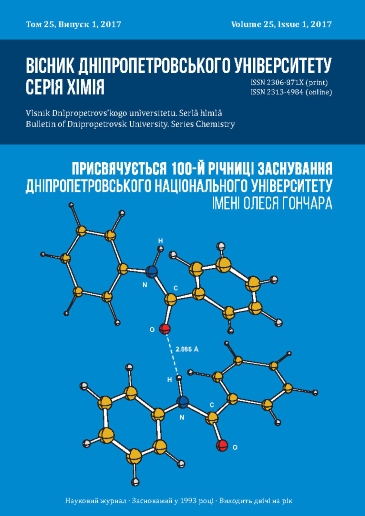The Hydrogen bonding effects in structural analysis of phenilon C-2: the quantum-chemical interpretation
DOI:
https://doi.org/10.15421/081702Keywords:
ab initio calculation, atomic charge, stabilization energy E(2), basis sets superposition error, scale factor, vibrational spectrum, hydrogen bondAbstract
Using ab initio methods of quantum chemistry the structure and spectral properties for molecular complexes, which were formed by monomer of phenilon С-2 chain, including some intra- and intermolecular hydrogen bonding effects as well as electrostatic interactions with evaluation of their contributions in total stabilization energy, have been investigated at natural bond orbitals theory. It is shown, that the overlapping of n1,2(O)→ σ*(NН) type with energies 15.4 and 9.5 kJ/mol, which correspond to the strong hydrogen bonding between amide groups, is a main direction for co-operating of some area for structural fragments of macromolecules. The proposed theoretical models are validated in reflection of spectral and energetic parameters for investigating system.References
Tokar, A. V. (2016). [Thesaurus in Polymer Chemistry]. Dnipro, Ukraine: DDAEU-DNU (in Ukrainian).
Burya, A. I., Kuznetsova, O. Yu., Tikhonov, I. V., Pelina, T. A. (2011). [Investigation of thermal resistance carbon plastics based on phenilon reinforced with Rusar-S fibre]. Kompozitnyie materialyi, 5(2), 53–58 (in Ukrainian).
Tokar, A. V., Chigvintseva, O. P. (2015). The quantum-chemical investigation of structure and spectral characteristics for molecular complexes in systems «polyarylate-terlon» and «penton-terlon»: a comparative analysis. Bull. Dnipropetr. Univ. Ser. Chem., 23(1), 16–20 (in Russian). doi: 10.15421/081503 CrossRef
Weinhold, F., Landis, C. R. (2012). Discovering Chemistry With Natural Bond Orbitals. New Jersey, USA: John Wiley & Sons.
Weinhold, F. (2012). Natural bond orbital analysis: A critical overview of relationships to alternative bonding perspectives. J. Comput. Chem., 33(30), 2363–2379. doi: 10.1002/jcc.23060 CrossRef
Sordo, J. A. (2001). On the use of the Boys-Bernardi function counterpoise procedure to correct barrier heights for basis set superposition error. J. Mol. Struct., 537(1–3), 245–251. doi: 10.1016/S0166-1280(00)00681-3 CrossRef
Kolandaivel, P., Nirmala, V. (2004). Study of proper and improper hydrogen bonding using Bader’s atoms in molecules (AIM) theory and NBO analysis. J. Mol. Struct., 694(1–3), 33–38. doi: 10.1016/j.molstruc.2004.01.030 CrossRef
Merrick, J. P., Moran, D., Radom, L. (2007). An Evaluation of Harmonic Vibrational Frequency Scale Factors. J. Phys. Chem. A., 111(45), 11683–11700. doi: 10.1021/jp073974n CrossRef
Vorsina, I. A., Grigoreva, T. F., Vosmerikov, S. V., Lyakhov, N. Z. (2015). Mechanocomposites on the basis of polyamide. Nauka i Studia, 5(136), 20–25.
Butyirskaya, E. V. (2011). [Computational chemistry: bases of theory and work with the programs of Gaussian and GaussView]. Moscow, Russian Federation: Solon-Press (in Russian).
Downloads
Published
Issue
Section
License
Copyright (c) 2017 Oles Honchar Dnipropetrovsk National University

This work is licensed under a Creative Commons Attribution 4.0 International License.
- Authors reserve the right of attribution for the submitted manuscript, while transferring to the Journal the right to publish the article under the Creative Commons Attribution License. This license allows free distribution of the published work under the condition of proper attribution of the original authors and the initial publication source (i.e. the Journal)
- Authors have the right to enter into separate agreements for additional non-exclusive distribution of the work in the form it was published in the Journal (such as publishing the article on the institutional website or as a part of a monograph), provided the original publication in this Journal is properly referenced
- The Journal allows and encourages online publication of the manuscripts (such as on personal web pages), even when such a manuscript is still under editorial consideration, since it allows for a productive scientific discussion and better citation dynamics (see The Effect of Open Access).


